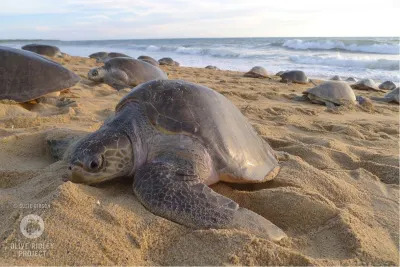The ability of animals such as sea turtles to migrate huge distances across the open ocean has long intrigued marine biologists. But, according to a recent article in The Guardian, some sea turtles may not be the expert navigators we once thought they were.
Conducted by an international team of scientists and published in the Journal of the Royal Society Interface, the research mapped the migrations of hawksbill turtles from nesting grounds in the Chagos Archipelago to foraging sites in the Indian Ocean.
Analysis of the turtles’ movements found that they typically travelled twice the distance needed to reach their destination, often meandering here and there over shorter migrations, suggesting their sense of direction in open ocean is rather rudimentary. One particular turtle swam 1,306-kilometres to reach an island located 176-kilometres away - travelling more than seven times the direct distance.

To achieve these findings, the team tagged 22 hawksbill turtles after they had finished nesting and tracked them via satellite as they moved on to better foraging grounds. Sea turtles typically nest and forage in separate geographical locations, meaning the hawksbills tracked “most probably hadn’t eaten for four or five months,” according to Prof Graeme Hays, chair in marine science at Deakin University and the study’s first author.
Previous research has suggested that sea turtles likely use an imprint of the earth’s magnetic field where they were born to help them navigate through the ocean, detecting changes as they move. According to Hays, the new study concludes that turtles “almost certainly are using a geomagnetic map, but it’s a fairly coarse resolution.” This means “it doesn’t allow pinpoint straight-line migration, but it does tell them when they’re getting a long way off route,” he said.
Hawksbill turtles typically migrate distances of about 150-kilometres, far less than some of their relatives. “For green turtles that nest in the Chagos Archipelago … we’ve tracked them going almost 5,000km to their foraging grounds,” Hays said. “They’ll swim all the way across the Indian Ocean to the mainland African coast.”
But, while hawksbills certainly make shorter migrations than green turtles, they tend to seek out small, specific locations such as remote isolated islands, making the task all the more tricky. The new study suggests that the sea turtles’ geomagnetic map is not detailed enough to accurately locate such specific targets.
Thankfully, their sense of direction is enough to get the turtles’ within a reasonable distance of their destination, after which, they likely rely on other senses such as sight and smell. According to Hays, turtles “can smell an island that they’re headed to” in the final stages of their journey.
“As they get some sort of visual landmark, for example, the water starts to get a bit shallower and they can see the seabed, then they probably got some sort of cognitive map of that area. They could probably just recognise the seafloor, just like you would recognise visual landmarks in the area where you live,” he said.
Want to go diving with sea turtles?
Contact one of our dive travel experts today

ZuBlu is the leading dive travel agency to search, compare and book scuba diving travel worldwide.




